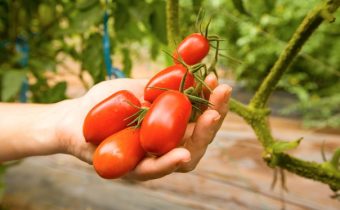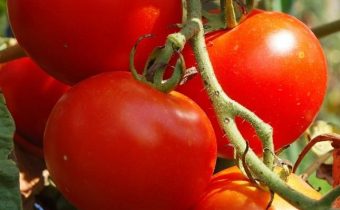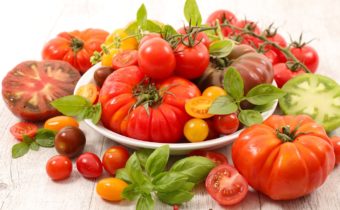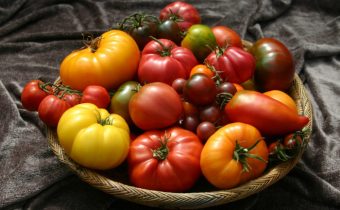Causes of flowers dropping off in a greenhouse and what can be done
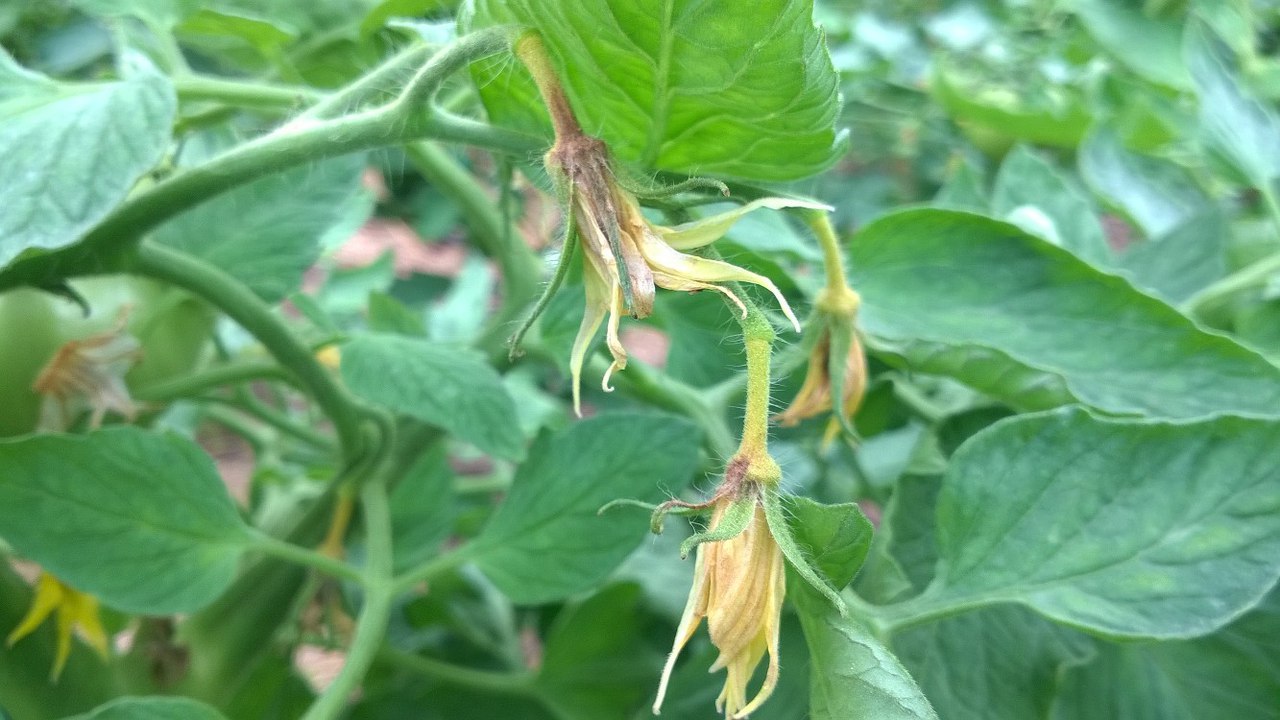
Tomatoes are very thermophilic plants, so vegetable growers try to grow them in a greenhouse. The conditions of the greenhouse are as close as possible to the natural microclimate of the crop, therefore the yield is in most cases pleasing.
But even when growing tomatoes in a greenhouse, you may encounter a drop in color. The reason for this may be various factors.
Causes and consequences of falling flowers in tomatoes
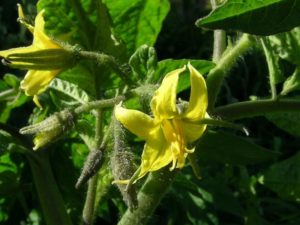 In 30-60 days, depending on the cultivar, tomatoes begin a flowering period. During normal development, flowers are fertilized by pollen, forming an ovary. But sometimes plants drop their color ahead of time. Most often this is the reaction of tomatoes to stress. Various violations of the rules for their care can provoke such a state of tomatoes.
In 30-60 days, depending on the cultivar, tomatoes begin a flowering period. During normal development, flowers are fertilized by pollen, forming an ovary. But sometimes plants drop their color ahead of time. Most often this is the reaction of tomatoes to stress. Various violations of the rules for their care can provoke such a state of tomatoes.
If you do not react in time and do not take proper measures, plants can lose most of the color. The consequence of this "color fall" will be a partial or even complete loss of the crop.
Reason # 1 Transplant during flowering
An error in calculating the time of sowing of seeds leads to the fact that tomatoes enter the period of flowering even on the home window sill. When transplanting seedlings lose up to 60% of all the roots and almost all the root hairs, which undoubtedly weakens the plants. Therefore, the color available on the bushes at the time of transplantation, as a rule, drops.
Do not rush to sow the seeds of tomatoes in the seedlings. When sown in January and February, the seedlings are “exhausted”. From the appearance of the first shoots to the landing on a permanent place should take no more than 50-65 days. At this age, plants tolerate transplant more easily, and the colors should not be on them yet.
Reason # 2 Violation of temperature
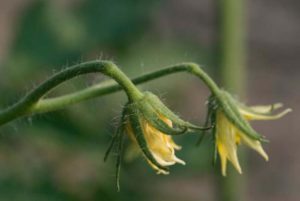 Falling flower buds may be due to too high or low temperatures. For normal fruit set, conditions are necessary without sharp temperature fluctuations. Maintaining a temperature of 20-25 degrees is considered the most favorable mode.
Falling flower buds may be due to too high or low temperatures. For normal fruit set, conditions are necessary without sharp temperature fluctuations. Maintaining a temperature of 20-25 degrees is considered the most favorable mode.
In extreme heat (above +30 degrees), pollen boils and does not pollinate flowers. As a result, tomatoes shed "fruitless" inflorescences. Lowering the temperature below 10 degrees Celsius is also a shock for the culture, as a result of which the pedicels dry up and fall off.
To avoid such situations, you need to try to keep the temperature in the greenhouse even. To lower the temperature, you can resort to the following methods:
- On hot days, open the greenhouse early, before 8 am. Cool outside air will prevent overheating of the plants.
- Keep the windows open. Hot air goes well through the vents in the ceiling of the greenhouse.
- Irrigate the paths in the greenhouse and the soil between the bushes with a fine pollinator in the daytime. Due to the evaporation of water, the air temperature will decrease by 2-3 degrees.
- Shade walls of the greenhouse with spunbond or whiten glass whitewash. This technique allows to reduce the temperature by 4-5 degrees.
Whitening the greenhouse from the heat, use the chalk solution (a pound of chalk per 10 liters of water). It is best to apply the solution with a garden spray pump on the external walls of the greenhouse.In the event of cloudy weather, such a coating is easily washed off with water from a hose or the first good rain.
To protect the landing from low temperatures, you must carefully monitor the weather forecast. In the case of an approaching cold front, it is necessary to protect the plants. This can be done as follows:
- Close the doors and windows of the greenhouse before the evening cooling.
- Install greenhouse arcs in the greenhouse in advance or construct a construction from wooden planks. On the eve of lowering the temperature, cover the plants with film or spunbond.
- Spread around the perimeter of the entire greenhouse containers with warm water.
- On the eve of frost pour tomato beds with warm water.
Reason №3 Insufficient illumination
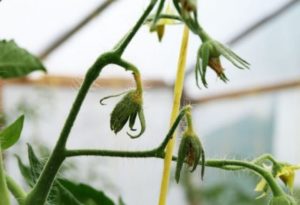 A sufficient amount of sunlight penetrates through the walls of the greenhouse structures. But with frequent planting tomato bushes are in shading. Due to the lack of light, the process of photosynthesis is disturbed, which makes the plants incapable of taking fruit.
A sufficient amount of sunlight penetrates through the walls of the greenhouse structures. But with frequent planting tomato bushes are in shading. Due to the lack of light, the process of photosynthesis is disturbed, which makes the plants incapable of taking fruit.
In order to save land, one should not use the accelerated planting of tomatoes. Get a big harvest from these beds will not succeed. For best results, observe the planting pattern recommended by the seed manufacturer.
Experienced gardeners to remove enough light to the plants remove some of the leaves from them. In this case, you need to follow several rules:
- you can cut the leaves under the brush with already formed ovaries;
- at the same time not to remove more than 2-3 leaves;
- the procedure is carried out in the morning in dry weather;
- use sharp and decontaminated tools.
Reason # 4 Excessive or insufficient humidity
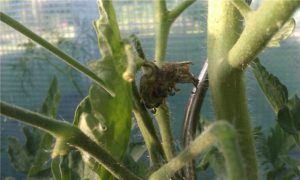 Optimum air humidity for tomatoes is 60-70%. With a deviation from these values, the normal water supply in the cells of tissues and numerous biochemical processes are disturbed. You can track the level of humidity using a special device - a hygrometer. In case of deviation from the norm, measures should be taken immediately.
Optimum air humidity for tomatoes is 60-70%. With a deviation from these values, the normal water supply in the cells of tissues and numerous biochemical processes are disturbed. You can track the level of humidity using a special device - a hygrometer. In case of deviation from the norm, measures should be taken immediately.
To increase humidity it is recommended:
- water tracks in the greenhouse;
- Place the water containers in the greenhouse.
If humidity is too high, take the following measures:
- in the morning shake off the condensate droplets from the tomatoes;
- Ventilate the greenhouse regularly;
- watering rarely and abundantly;
- After watering, cover the soil for a while with straw or a transparent film.
Purchased air moisture meter can be replaced with a homemade device. To do this, you will need two mercury thermometers and a psychometric table, which can be found on the Internet. Both thermometers are placed on the same vertical surface, while the tip of one is immersed in water. Given the difference between the readings using the table, you can determine the level of humidity.
Reason # 5 Poor pollination
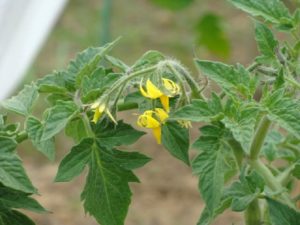 The reason for poor pollination of flowers can be various factors. Some of them have already been mentioned above, this is a violation of the temperature and humidity norms. In addition, insects are in no hurry to fly into the greenhouse, which also adversely affects pollination. To help tomatoes pollinate, you can use the following techniques:
The reason for poor pollination of flowers can be various factors. Some of them have already been mentioned above, this is a violation of the temperature and humidity norms. In addition, insects are in no hurry to fly into the greenhouse, which also adversely affects pollination. To help tomatoes pollinate, you can use the following techniques:
- make drafts in the greenhouse during the daytime;
- shake bushes or flower brushes in the morning;
- near the vents, hang containers with sweet water to attract insects;
- during flowering sprinkle the leaves and flowers with the preparation “Bud”.
Reason number 6 Lack of trace elements
Nutrient deficiencies are one of the common causes of color loss in tomatoes. The culture is particularly sensitive to the lack of nitrogen, phosphorus and boron. Determine which element is not enough culture can be on the appearance of plants:
- Nitrogen - young leaves become shallow and acquire a reddish tint, and old ones turn yellow;
- phosphorus - leaf plates change color to purple, their edges dry;
- boron - young leaves twist from tip to stem.
If you find one of the signs, you must urgently fill the nutrient deficiency:
- top dressing with nitrogen - for 10 liters of water dilute 0.5 liters of mullein and 1 tbsp. spoon Nitrofoski and water the tomatoes (flow rate of 0.5 liters per bush);
- top dressing with phosphorus - 50 grams of superphosphate is dissolved in five liters of water and is watered at the root (flow rate 0.5 l per bush);
- top-dressing with boron - 10 grams of boric acid are applied to ten liters of water, and the resulting composition irrigates the tomatoes abundantly in leaves and flowers.
With a slight boron deficiency, the plants may look healthy, but the ability to form ovaries is lost. Therefore, foliar top dressing with boron is recommended twice: before the beginning of flowering and after the first brush blooms.
General recommendations for growing tomatoes in the greenhouse
In order not to interfere with the fall of color, you should follow the general recommendations for growing tomatoes:
- Purchase varieties intended for growing in greenhouse conditions and adapted to the climate of your particular region.
- Build bushes strictly in accordance with the recommendations of the seed originator.
- Adjust the number of floral brushes, and do not overload the plants.
- Observe the planting scheme, depending on the characteristics of the variety.
- Regularly carry out preventive treatments for diseases.
- Disinfect the interior of the greenhouse in spring and autumn.
- Rationally use fertilizers when feeding, do not overfeed tomatoes.
Faced with such a nuisance as dropping flowers in tomatoes you should not despair and complain about an unsuccessfully chosen variety or a bad year. After analyzing the conditions of growing plants and finding out the true cause of the unpleasant phenomenon, you can quickly cope with it and get a decent harvest.


